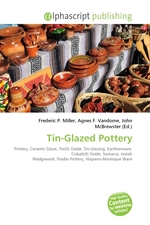Tin-Glazed Pottery
Frederic P. Miller, Agnes F. Vandome, John McBrewster
бумажная книга
High Quality Content by WIKIPEDIA articles! Tin-glazed pottery is pottery covered in glaze containing tin oxide which is white, shiny and opaque. (See tin-glazing.) The pottery body is usually made of red or buff colored earthenware and the white glaze was often used to imitate Chinese porcelain. Tin-glazed pottery is usually decorated, the decoration applied to the unfired glaze surface by brush as metallic oxides, commonly cobalt oxide, copper oxide, iron oxide, manganese dioxide and antimony oxide. The makers of Italian tin-glazed pottery from the late Renaissance blended oxides to produce detailed and realistic polychrome paintings. The earliest tin-glazed pottery appears to have been made in Iraq in the ninth century, the oldest fragments having been excavated during the First World War from the palace of Samarra about fifty miles north of Baghdad. From there it spread to Egypt, Persia and Spain before reaching Italy in the Renaissance, Holland in the 16th century and England, France and other European countries shortly after.
Данное издание не является оригинальным. Книга печатается по технологии принт-он-деманд после получения заказа.


